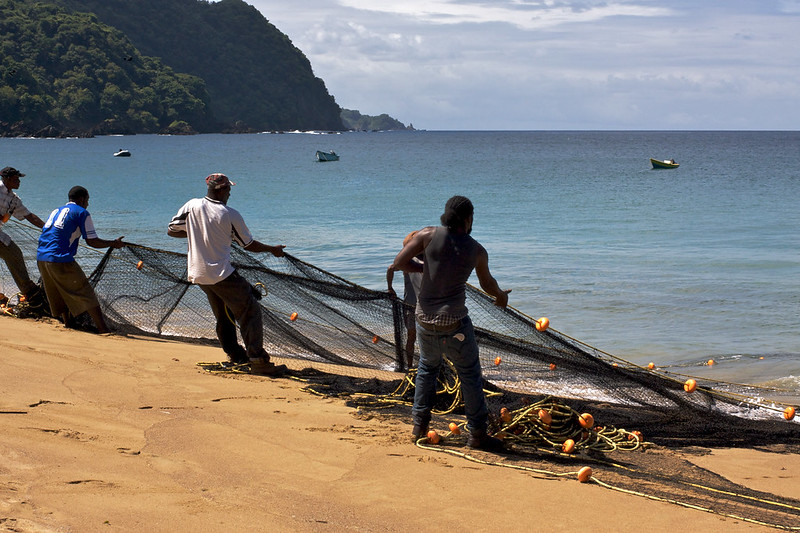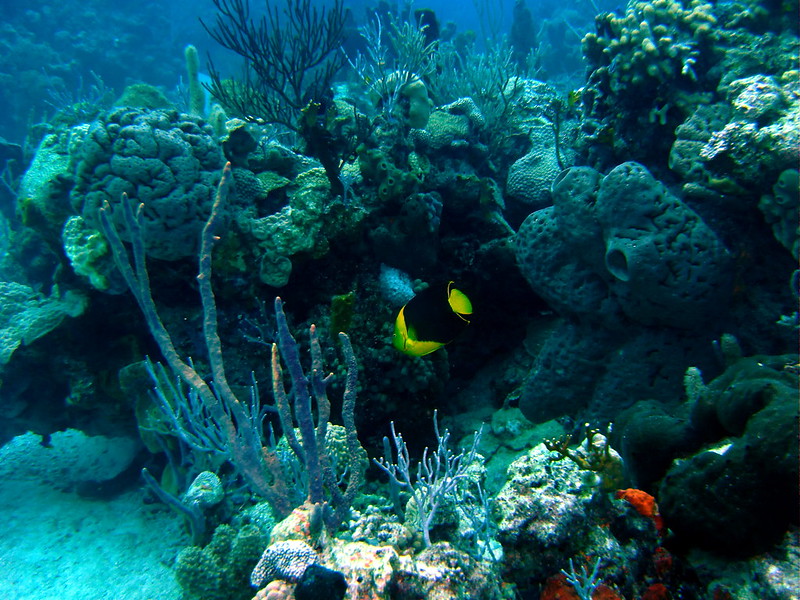Small island nations call for deep reform of climate finance

The Covid-19 pandemic and its economic fallout have been disastrous for Small Island Developing States (SIDS), which were already highly vulnerable to climate change and other shocks and stresses. A policy roundtable at ODI on 28 July 2021, convened by Courtenay Rattray, High Representative, UNOHRLLS, and Dr Emily Wilkinson, Senior Research Fellow, ODI, examined SIDS’ special case for finance and debt relief – and highlighted specific action areas that international donors and financial institutions could take to support SIDS, on the road to COP26 in Glasgow and beyond. Mairi Dupar reports.
Climate frontlines
SIDS are at the frontlines of the climate crisis: they are highly exposed and vulnerable to climate variability and change, ranging from rapid-onset hazards, like tropical storms with high rains, winds and/or waves; to slow-onset hazards, such as sea level rise.
The latest report by the Intergovernmental Panel on Climate Change, Climate Change 2021: The Physical Science Basis, has underlined the dangers of climate change to SIDS. The IPCC finds that extreme weather events such as heavy rainfall and heatwaves are likely to intensify and become more frequent this century.
Economic vulnerabilities
SIDS also face structural challenges to their economic development, which the United Nations has recognised in its adoption of the ‘Small Island Developing States Accelerated Modalities of Action – SAMOA Pathway’, in 2014. The SAMOA Pathway treats SIDS as a special case for sustainable development, recognising “that the financial resources available to date have not been adequate to facilitate the implementation of climate change adaptation and mitigation projects, and …complex application procedures have prevented some Small Island Developing States from gaining access to funds that are available internationally.”
The Covid-19 pandemic and the economic shock associated with it have dealt a further blow to SIDS. Many SIDS are heavily dependent on tourism for revenue, which nose-dived during the pandemic. Covid-19 lockdown measures have stalled trade and foreign investment for many SIDS, too. Finance for climate-resilient and low-carbon development is scarcer than ever.
Meanwhile, small island nations continue to be battered by extreme weather events and climate change: “As the sea level rises, biodiversity is lost, reefs are bleached, freshwater lenses are salinised, opportunities for SIDS to adapt to climate change and achieve the SAMOA Pathway are increasingly jeopardised. Countries hit ever more frequently by climate disasters can find themselves in long-term debt traps. We know what this vicious cycle looks like: high debt servicing costs, insufficient financing for resilience, leaves SIDS vulnerable to disasters. Then, as disaster strikes, external borrowing is needed to see to the immediate needs of citizens and to recover, leaving SIDS even more indebted and vulnerable to the next disaster,” said Courtenay Rattray at the roundtable.
Baroness Scotland, Secretary General of the Commonwealth Secretariat seconded this view. She noted that the consequences of the Covid-19 pandemic are pushing debt levels to record highs in SIDS. “Such debt burdens constrain the fiscal space for national development and impede the ability to enhance climate and disaster resilience and meet global climate change commitments including the Paris Agreement targets and the 2030 Sustainable Development Goals,” she said.
For Tarran Simms, a young professional working in the sustainable tourism sector in the Bahamas, SIDS now face a crisis of financial liquidity and multi-dimensional vulnerability that needs urgent resolution: “With key economic sectors being impacted by climate change along with Covid, the economies of SIDS are hanging in the balance. Access to financing is needed now,” Mr Simms urged.
Coordinated international action needed
Baronness Scotland identified that ‘coordinated action at international level is key’ to addressing SIDS’ debt crisis and its link to resilience. “Simplified and more accessible global climate finance architecture, mechanisms and tools are needed to deliver international financial assistance and debt relief,” she said.
H.E. Gaston Browne, Prime Minister of Antigua and Barbuda, called for a total reform of international climate and development financing. He took aim at the current eligibility criteria for concessional finance (grants and low-interest, long-term loans) by international financial institutions and lender governments. Many SIDS are no longer eligible for such finance, and can only access higher interest loans, because they have graduated out of ‘least developed’ status.
Donors, international financial institutions, multilateral agencies and the UN system should reform their assessment tools to permit concessional and grant financing especially for island nations, H.E. Browne said. “We need the international community to not only listen but to demonstrate support through concrete actions.”
Describing in more detail how a reformed international finance system could look, Mr Rattray of UNOHRLLS suggested: “Sustainable access of SIDS to development finance cannot be achieved without progress in reforming the international debt architecture. This reform should include agreement on a global sovereign debt restructuring mechanism and the establishment of a multilateral credit rating agency. Excellencies, structural and inherent vulnerabilities require transformative and decisive action. One potential avenue is the adoption of a multidimensional vulnerability index, a MVI, to ensure vulnerable countries can access concessional finance to finally achieve resilience.”
Debt-for-climate swaps
Roundtable participants discussed debt-for-climate swaps as a mechanism that could break SIDS’ vicious cycle – whereby they suffer disasters, but lack sufficient finance to build back resiliently.
Debt-for-climate swaps are “a type of debt swap in which the debtor nation, instead of continuing to make external debt payments in a foreign currency, makes payments in local currency to finance climate projects domestically on agreed upon terms” (Climate Policy Initiative, CPI).
A delegate from an international financial institution said that there is interest in using debt-for-climate swaps more widely. To date, these swaps have been very country-specific, and not suitable for straightforward replication elsewhere. Nonetheless, the delegate said, many closed-door conversations are currently underway to identify what kind of ‘contingent debt relief’ may be possible if borrower countries ‘increase investments in green recovery’.
An African delegate noted that Cape Verde is seeking to develop a debt-for-climate swap, and this is raising issues ‘around the capacity building that is needed’ to make these arrangements a success.
“What would really help is clear messaging from institutions that this (debt-for climate-swap) should be seen as something that is routine as part of restructuring and not something that is ad hoc, or something that countries adopt only if they are in debt distress,” the delegate said. “Rather, it’s a means of getting liquidity into the key areas that enhance resilience.”
Justice for young people in SIDS
For younger generations growing up and joining the workforce in SIDS, the acuteness of these multiple crises has created what Dr Wilkinson et al, in a framing policy brief for the event, call a “triple jeopardy.” Young people in SIDS “will inherit crippling debt, a degraded environment, and frequent and destructive disasters,” they argue. “There is a historical and moral obligation for development partners to help SIDS overcome the structural challenges that they face – even if these cannot actually be removed.”
Young people are not standing by – they are ready to act. Tarran Simms, the young tourism entrepreneur from the Bahamas, stressed that this generation is eager to develop the tourism sector sustainably for the future. For this to happen: governments need to cooperate to remove the structural barriers that are hindering the kind of investment in resilient, environmentally sustainable infrastructure and services that SIDS need.

Conclusion: SIDS can’t do it alone
In the past, SIDS “have faced pivotal moments when policy agendas have undergone a marked shift in emphasis and direction – for example, the loss of trade preferences for exports to Europe under the Lomé Convention” note Wilkinson et al, in their briefing note.
“The confluence of increased attention being paid to climate change adaptation at the 26th UN Climate Change Conference of the Parties (COP26) in Glasgow, post-Covid-19 ‘green’ recovery and debt restructuring, and shifting donor agendas (notably in the United States and United Kingdom) may well constitute one of these pivotal moments,” they continue.
H.E. Gaston Browne of Antigua and Barbuda concurred that the run-up to COP26 provides a critical moment for SIDS’ development partners to “fulfil their commitments and formulate a new global financial goal commensurate with the new global realities.”
“The international community (should) create the enabling environment for us to climb to greater heights and achieve our ambitions. It’s important that we continue to collaborate with each other and that the large emitters and developed countries continue to work with SIDS to address the existential threats posed by climate change,” said Mr Browne.
Image (top), fishers, Trinidad; courtesy K Rogers